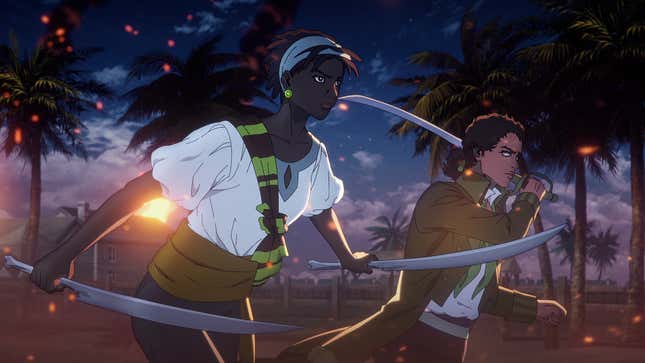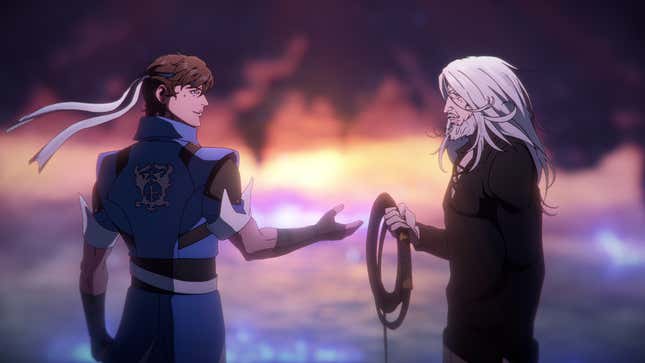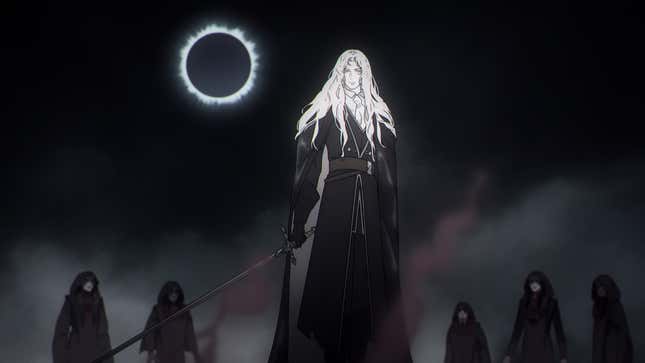Castlevania: Nocturne is here, and ready to usher in a new generation of monster-slaying heroes and suitably monstrous threats for them to slay. But now that Netflix and Powerhouse Animation’s latest entry in the video game adaptation saga is streaming, we spoke to some the team behind the show to learn about the season’s biggest moments.

Advertisement
Much like the initial season of its predecessor, Nocturne does much to set up a lot of promise for the future by the end of its eight episodes. It ends with a clear and ready indicator that team is ready to tackle arguably the most iconic Castlevania narrative of all time, Symphony of the Night, as Richter and his allies find themselves bolstered in the darkest hour by the arrival of a familiar face… well, to us, at least, even if our young heroes aren’t as up on their Castlevania lore as gamers are.
But a lot goes down in Nocturne’s first season—of hopefully several—beyond just the last-minute arrival of returning hero Alucard Tepes (Battlestar Galactica’s James Callis reprising his role from the first Castlevania) to help another member of the Belmont Clan out of a supernatural nightmare. To learn more about some of the biggest twists and moments of the series, from Annette’s majorly redeveloped backstory at the heart of Haiti’s revolution to Richter’s own big hero moment—set to the legendary Castlevania game track “Divine Bloodlines”—and more, io9 recently spoke to series writer Clive Bradley, and co-director Sam Deats. Check out our full interview below!
Advertisement
Advertisement

James Whitbrook, io9: Annette and Eduoard’s story broadens Nocturne’s historical and sociopolitical revolutionary themes beyond France’s class struggles into a story of slavery and colonialism. Can you tell me a bit about the decision to explore her background in this way, and why it was important to give this version of the character what becomes a key, serious core of Nocturne’s narrative?
Clive Bradley: My train of thought with Annette was this: Rondo of Blood is set in 1792, which is the middle of the French Revolution. So why not set it then, make something of the time it’s set? And I feel you can’t really understand the French Revolution without knowing something about the Haitian revolution (which started in 1791). The French Revolution abolished slavery—but one reason, probably the main one, it did so was because the slaves had abolished it themselves in the French colony of St. Domingue (or had started to do so, Napoleon later tried to restore slavery, but the people of St. Domingue defeated him). So how could we include this element in the story?
The character of Annette, trapped in a castle, made me think of Esmeralda in The Hunchback of Notre Dame—this extraordinary woman who sweeps into France. It seemed an obvious step to make Annette a revolutionary from St. Domingue/Haiti on that sort of model. This Annette would probably have had roots in West Africa. I was keen to involve writers with that heritage, so I brought on Temi Oh and Testament and Zodwa Nyoni (who is herself in fact from Zimbabwe). They helped develop Annette’s magic, her links to the West African god Ogun, and so forth. Later we had a Haitian adviser on board, Cècile Accilien, who helped us with aspects of the history and culture. We wanted it to be as authentic and grounded in reality as possible.
Advertisement
io9: I think one of the most interesting things about Nocturne is how you really dig into the fact that Richter and his allies are, for the most part, very young kids compared to Trevor and Sypha. The generational/age-gap story becomes even more important when Richter eventually meets Juste and explores his magical history. What drew you to introducing another Castlevania legacy character in this way?
Bradley: I just loved the idea of Richter’s grandfather as this bitter old guy who’s been through hell, lost his magic (which at the point they meet is also true of Richter)—kind of the opposite of Richter, or an image of how Richter could end up if he doesn’t evolve into the hero he needs to be. The character in the game has a tragic story, so I used that. It seemed a very important aspect of Richter, Maria and Annette that they’re all teenagers, all kids. So Juste as a contrast to that was an important thing to explore.
Advertisement
Sam Deats: I just wanted to add that Juste is a really special inclusion in the series for me, and Clive brought him into the show in a really great way that resonates really well with the Castlevania fan in me. He wasn’t originally in Rondo of Blood, since Harmony of Dissonance came out much later, but it made sense within the time period and for the story that he would have a presence. I’m really excited for folks to see how his character develops!

Advertisement
io9: Of course, that encounter then leads to a highlight of the season, Richter embracing his magic to save himself and Juste. It’s a fantastic moment, and it’s when game fans get their music moment with “Divine Bloodline”s making an appearance. Can you talk a bit about ideating that whole sequence, not just from a direction and character perspective for Richter to have this moment, but also the logistics of scoring it to such an iconic piece of the games’ musical history?
Deats: I basically had this sequence playing out in my head all the way back at the story proposal stage, back when it was a pretty short blurb of the basic idea. I immediately imagined “Divine Bloodlines” playing in my head and Richter erupting with the Grand Cross, and everything. I had been working out Richter’s fighting style with his magic in my head even since before the story proposal, so from there it was just about solidifying those into teases of his unique fighting style within the context of the sorts of foes he was facing.
Advertisement
I timed the sequence out to “Divine Bloodlines,” but honestly at the time we weren’t even sure if we would get the song, I was just determined and very insistent of holding on to that vision, and fortunately it all worked out in the end. We never had to do another music track for the sequence, fortunately—Trey [Toy] and Trevor [Morris, Castlevania’s co-composers] got to dive right into composing their version of “Divine Bloodlines,” and delivered 1,000%.

Advertisement
io9: Akin to season one of the original show, Nocturne ends on quite the cliffhanger—Richter, Maria, and their allies on the back foot, Erzsebet’s plans coming to fruition, and, of course the return of Alucard teasing plot elements from Symphony of the Night. What led you to that kind of parallel with the original show, and the decision to end Nocturne where it does, and what were the conversations about bringing Alucard back in this moment?
Bradley: The design question is for Sam and Adam [Deats]. Why at this point? That connects to the cliffhanger question. Once we’d decided a cliffhanger was that way to go, well… if you’re going to have a cliffhanger, best make it a good one! We knew Alucard was going to show up at some point, but this just seemed the perfect moment to do it.
Advertisement
Deats: So there’s almost a bit of a debate about Alucard’s design and whether he has intended to have pale blonde hair or white hair in Symphony of the Night based on the artwork of him and even his character’s sprite in the game. At the time of designing him in the original series, though, I decided to lean towards the pale blonde hair in order to invoke his mother, which was appropriate to the story. His hair got more saturated during lighting/compositing than I had ever intended, though, which was a constant frustration of mine. But even back then I tinkered with the idea that if we were to jump forward in time, to show how time has passed by leaning more towards the white haired direction (this also had the added benefit of not being something we would have to worry about getting over-saturated during lighting!).
We did play with looks that leaned even closer to his Symphony of the Night look, but for Nocturne, we wanted to invoke his SOTN look while also reflecting that this is a version of him that’s been awake and fighting for 300 years—a little more battle-worn—and also showing up in the story sooner than he did in SOTN. As a fan I do love that we’re getting to develop these characters’ relationships in a direct and meaningful way.
Advertisement
Castlevania: Nocturne is now streaming on Netflix.
Want more io9 news? Check out when to expect the latest Marvel, Star Wars, and Star Trek releases, what’s next for the DC Universe on film and TV, and everything you need to know about the future of Doctor Who
Services Marketplace – Listings, Bookings & Reviews